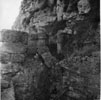Description: Limestone altar, moulded above and below
(w:
0.50 x h:
1.10 x d:
0.40);
one of a set of six altars, C.323, C.324, C.325,
C.326, C.327, C.328.
Text: Inscribed on one face. a. is written on the moulding while
b. is on the face below.
Letters: Probably second century, 0.08, lunate epsilon.
Date: Probably second century CE
Findspot:
Cyrene:
Fountain Terrace:
Found probably in 1931, collected together; the inscriptions were turned face inwards,
near the rock face, beside the Byzantine lime kilns.
Original location: Unknown.
Last recorded location:
Fountain Terrace.
English translation
Translation by: Charlotte Roueché
For Aphrodite, source of life
Commentary
All the altars in this set that can be legible contain unusual elements. There is a discussion by Pugliese-Carratelli (1963).
b: The epithet is applied to Asklepios in IG II,2, 4494 (at PHI 6785), but we have not found it elsewhere of Aphrodite. She is perhaps analogous here to Venus Genetrix; or the term may imply a more philosophical approach See also Damoxenus 2.8, at Athenaeus 60.16 (available inPerseus) ἡ φύσις πάσης τέχνης ἀρχέγονον ἐστι; so Diodorus Siculus, 1.88.1 (at Perseus) τὸ γεννητικὸν μόριον of Priapus which is to be honoured ὡς ἄν ὑπάρχον ἀρχέγονον τῆς τῶν Ζῴων φύσεως (Com., ND 8, Ὠκεανὸς ἀρχέγονος πάντων, ND 17, τὸ ἀρχέγονον ὑγρόν). See also Aphrodite as παγγενέτειρα in Orphic Hymn 55. Another possibility is that ἀρχέγονος = πρωτόγονος, 'first-born'.
Bibliography: SECir, 1961-1962, 156.4, fig 118 (drawing only, from T. XXI, 7-10), whence Robert, Bulletin Épigraphique, 1964.570; Catani, 2007, 4 whence SEG 57.2021, Dobias-Lalou, Bulletin Épigraphique, 2008.604
Text constituted from: Transcription (Reynolds).


